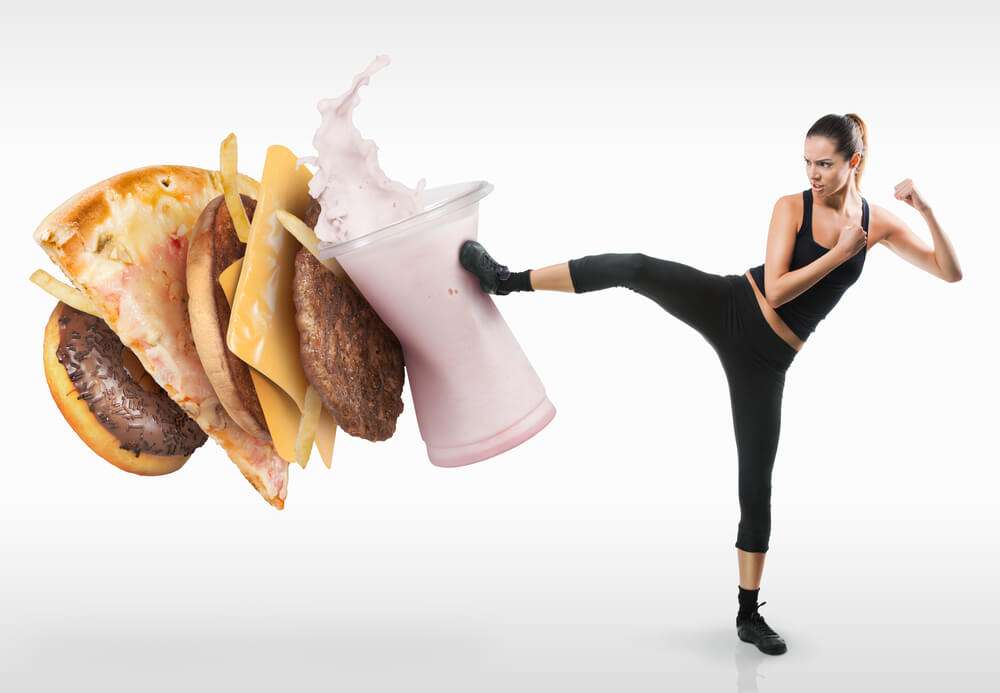
Fighting Hunger and Food Cravings: Looking for Tips to Lose Weight And Keep Control Over Your Hunger? Today we’ll share what you need to know.
One of the biggest challenges most people face when it comes to losing weight is keeping their hunger at bay. While you might not struggle to find a diet, the real struggle is finding a diet that works for you and one you’re able to live with.
The problem: impulse eating and food cravings can totally derail your progress.
How to control hunger is one of the hardest parts of any diet. Your body isn’t used to the change you’re implementing – therefore, it’s going to send signals that it’s hungry. Like, really hungry. And you might find yourself reaching for those chips or pasta before you can tell yourself no.
Hunger can blind you and rob you of the dedication you had for your diet just a few minutes ago.
It’s also difficult when you’re trying to remain in a dieting or caloric deficit state for longer periods of time. Most people have done the crash diets where you only have to suffer for a few weeks or even just days. Because the end is in sight and they have a specific end date in their mind, they tend to stay more motivated. It’s a temporary diet, so their comfort is temporary.
Steady weight loss requires you to stay in a lower calorie intake state. There isn’t an end in sight because it isn’t just a diet – it’s a lifestyle.
When you’re cutting back on your calorie intake, the results can vary. There are some extremely lucky people that don’t really feel uncomfortable when they’re restricting themselves. This means they don’t see a drop in their energy levels and they aren’t dealing with some majorly unpleasant feelings, like hunger pangs or food cravings.
As for the rest of us, it’s going to be harder, because we are dealing with harder cravings and hunger impulses. Some of this comes down to body types. There are challenges for each type of body. Some people build muscle easier, some lose fat easier. Either way, if you’re switching to low carb, odds are, you’re going to feel lethargic at first. So you’re going to need high nutrient foods to fuel your body.
Understanding Hunger Impulses and Food Cravings
So…what the heck? How can we keep hunger away, fight food cravings and stay true to the diets we promise ourselves?
There are three different hormones that regulate our natural instinct to eat. Those hormones are insulin, leptin and ghrelin.
Because of this, some experts wonder, are leptin and ghrelin the keys to weight loss?
If you go several hours without eating, and your body has already finished absorbing and metabolizing the nutrients you had at your last meal, you’re going to see insulin levels drop to a “baseline” level. Why? Because it’s a big part of insulin’s job to give food nutrients from the blood a ride into the cells in order to put them to good use.
From here, ghrelin levels are going to increase, and so is your level of hunger. So when you finally reach for that piece of fruit or grab a meal, your leptin levels go back up, essentially turning off your hunger.
Do you know that one of the best things you can do to avoid impulse eating of unhealthy foods is to keep healthy snacks around?
A simple bag of almonds in the car can be a powerful tool for avoiding unhealthy food impulses.
So with hunger and these hormones, that’s how all that works…until you’re cutting back on calories. During this time, circulating leptin levels are going to go down, and ghrelin levels are going to surge. And as your body loses more and more of its fat, these leptin levels are going to keep going down even more.
What does this all mean? Basically, dieting in order to see some weight loss results is going to make you feel hungry. What you reach, and what is in reach are going to have a major impact on your success.
Feeding Your Body Right to Prevent Food Cravings
So what in the world does your body want from you? Your body’s goal is to reach an energy balance. You need to consume just as much energy as your body uses. It doesn’t want to stay in a deficit.
When you listen to your body and go off track by eating more than you should have, it really doesn’t take a lot to put a blockade in your weight loss plan. Just taking a few extra forkfuls of a calorie-rich food at every meal can help you get rid of the deficit feeling and stick your weight.
And this is why keeping control of hunger is so important when it comes to dieting and weight loss. If you throw in the towel, even for a day, you’re not going to lose weight. But if you trek through the rough dieting months, you might get “hangry” sometimes.
So how can we possibly win?
You can defeat food impulses before they happen with a high protein and fat diet.
Knowing how to fight hunger impulses with dietary strategies is the route to go. Now we aren’t promising that it’s going to be an easy process. When you’re turning to a diet to lose weight, it’s never going to be as satisfying as eating at an all-you-can-eat buffet. But there are a couple of strategies you can implement into your daily routine to make your diet more doable.
Fighting Food Cravings Tips
Fighting food cravings comes down to stopping them before they start. So, here are our tips for keeping your body fueled right even when you’re dieting to avoid impulse eating.
Get at least 30-40% of your calories from protein.
You can make this happen easily by including protein in every single meal you eat. Think of it this way – you want to lose weight. Protein will help you get to that weight. Therefore, protein is your friend. A clean protein powder is an excellent way to fight hunger between meals. Protein basically offers no fat storage and it helps preserve your muscles. Plus, there’s tons of research that proves having a diet that’s high in protein can dramatically decrease your overall appetite. This could be because it increases leptin sensitivity, so you’re going to feel fuller for longer and be satisfied after each meal. Wondering how much daily protein do you need to build muscle?
Next, be wary of cutting all carbs at once.
Low-carb diets have been and always will be a huge diet people turn to. But they aren’t always the best choice and you are likely to find yourself experiencing some food cravings. So, gradual can be a better approach for phasing out carbs for a short time to cut fat. However, cutting your carb intake causes a potential drop in strength, because you have lower levels of glycogen. Plus, a lot of people just feel hungrier overall, so be aware of your body’s signals.
Diets high in fat are key to reduced satiety.
There’s a lot of data that proves diets high in healthy fat and low in carbs reduce 24-h circulating leptin levels. So basically, diets high in fat are key to reduced satiety. It’s also likely that dietary fat persuades leptin resistance, as it has been shown in animal research. As for carbs…well, the more carbs you eat, the higher your 24-h circulating leptin levels are going to be. So if you have a high protein and a medium carb intake diet, you’re going to have double the amount of satiety. And that’s what it’s all about – keeping you full and fueled, especially if you want to build muscle while losing fat.
Bump up your fiber intake.
Fiber is the indigestible part of food that absorbs water while it moves through your digestive track. In plain terms – it helps you have better poops. Really. Plus, there’s a solid amount of research that shows fiber keeps you fuller for longer. You can easily increase your fiber intake by eating a lot of fibrous fruits and veggies. If you can, try to incorporate one at every meal. Or, if you’d rather, you can always use a supplement fiber, like psyllium seed husks. These helpful supplements literally expand when they get to your stomach, so you get the feeling of being full. In terms of how much fiber you should be eating, let’s look at what the Institute of Medicine had to say. They recommended children and adults aim for 14 grams of fiber for every 1,000 calories eaten in a day. So if you’re on a 2,000 calorie diet, you’ll want to shoot for 28 grams of fiber every day. It might seem like a lot but adding a few fibrous foods to every meal is the easiest way to do it.
Nuts are a Satiety Superfood.
Seriously. Nuts are packed full of protein and fiber, so as you probably know by now, these two will keep your full. They’re also a good dose of healthy fats. And there are countless studies that prove eating nuts on a regular basis cuts down your risk of gaining weight. So there isn’t really any negative side to consuming more nuts. Get crackin’!
Don’t forget to drink water.
With every meal, you should have a water glass right next to you. 30 minutes before your meal, drink an 8 ounce glass of water. Then, have 1 to 3 more glasses while you’re eating. There’s a decent amount of research that drinking water with each meal increases your satiety while eating, so you’re going to eat a lot less. Keep a high BPA-free water bottle with you at all times and drink up before you grab for snacks.
Avoid High GI Carbs.
The carbs to avoid would be high-glycemic. The glycemic index (better known as GI) is a scale that’s used to measure the way different carbs effect blood sugar levels. Carbs that would be considered low on the GI are the ones that break down slowly and release glucose into the bloodstream slowly. On the flipside, if a carb breaks down very quickly and releases glucose into the blood quickly (which causes insulin levels to go up abruptly) it’s going to be higher on the GI. In terms of numbers, anything below 55 is considered low on the GI scale and anything above 70 would be considered high. 100% pure glucose is registered as 100 on the GI.
Research and data have proven that the quick absorption of glucose that tends to happen after eating a high-glycemic carb jumpstarts a whole metabolic and hormonal process that, in turn, makes you want to eat even more. And let’s face it – a majority of the high-glycemic foods are processed junk foods that hold little to no nutritional value. All you need to do it replace those with low-glycemic and unprocessed foods. You’ll feel better overall and keep your hunger under control.
Try eating slower.
We know it can be hard to eat slowly, especially if you’re on a diet and are finally getting the meal you’ve been waiting all day for. But eating slower is going to result in eating less, as you’re giving your brain the chance to register that it’s full. After all, don’t you want to enjoy every single bite? So take a deep breath and a step back.
Give 5-HTP a try.
5-HTP supplements are a popular mood boosting tool. It’s also found in things like pumpkin, potatoes, meat, milk and specific greens. It’s a compound that’s involved in the metabolism of tryptophan. And it matters because when it gets to the brain, it’s converted into serotonin. As you probably know, this is one of the main neurotransmitters that helps you feel happy. This can also influence your eating behaviors. Speaking of foods that make you feel happy, did you know that eating chocolate can be healthy?
Solid research proves taking 5-HTP with food not only helps you control how much food you eat, but it also gives you a major boost in feeling full. And as an added bonus it’ll help ward of cravings for carbs. Check your local store for 5-HTP.
Getting enough sleep.
This is also an area that a lot of dieters skip on. Did you know that a sleep mask could be one of the cheapest ways to improve your health? Blocking out light and getting a full night’s sleep has huge benefits whether you’re dieting or not.
When you don’t get at least 8 hours of sleep per night, your ghrelin levels are going to increase and leptin levels are going to go down. One study uncovered that people who slept 5 hours a night had a 15% drop in leptin levels and a 15% increase in ghrelin levels, as opposed to those who slept for 8 hours. The results weren’t shocking – the less sleep people got, the more fat they had. Now of course, the amount of sleep you need varies depending on many different factors, but the National Sleep Foundation recommends every adult to get at least 7 to 9 hours of sleep every night.
Conclusion
The key to fighting food cravings is to giving your body what it really needs. This way, even when you are in caloric deficit to lose weight, eating impulses will be controlled. Managing hunger impulses is a deciding factor in how successful you will be with fat loss. Try these tips and you’re bound to find success.
Latest posts by Terry M (see all)
- Garage Gyms - Aug 1, 2018
- Kettlebells – Why They Should Be Added To Your Routine. - Jul 24, 2018
- Weight Belts: What Are They Really For? - May 31, 2018















could not have said it better myself Terry proper diet and nutrition is just so important If you want to build muscles you have to start off by watching your diet, you can’t just expect to lift a bunch of weights and build muscle if your diet sucks, lifting weights is easy, but cutting out junk food can be tough, when you have finally gotten your diet in check than focus on lifting heavy and hard, but the most important thing is being consistent and keeping a log and a good routine going, you won’t get very far if your inconsistent in this game, start off by doing big compound movements, such as squats, pull ups, deadlifts and such, I know it’s tough for a lot of folks to find a good routine to keep them going but it’s vital that you do this, I’ve made some amazing gains in just a few months thanks to the advice I got over at aestheticreview.com this guy really helped me get a great program going that allows me to keep track of my weight and gains using a really neat tool, as well as an awesome routine, anyways good luck and never give up on your journey to making big gains!